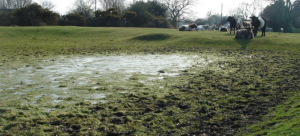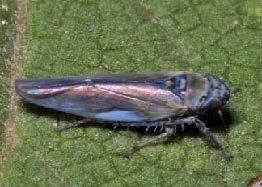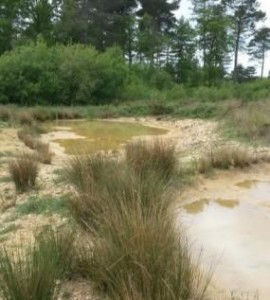Introducing the Flagship Ponds Project
24th August 2015
Many of our nation’s most beautiful and biodiverse waterbodies have degraded irrevocably. It is critically important that the remaining sites are well protected.
Flagship Ponds are the very best of Britain’s Priority Ponds: sites of national importance because of the threatened species or communities they support. We are now six months into a 3 year project to help support the long-term sustainability of 70 Flagship Pond sites across England and Wales.

The Flagship Ponds Project aims to ensure that the people looking after at least 70 Flagship sites in England and Wales have all they need to secure the ponds’ futures, including: enough information and knowledge to manage their Flagship Ponds successfully and maintain their quality and the key species they support, an effective management plan, regular monitoring for key species and pond quality, funding to support management or habitat creation if needed, and an early warning system (e.g. regular site checks) to prevent inadvertent damage.
Where one or more of these monitoring and management targets is not already in place, we are keen to provide support through the Flagship Ponds Project.
The aim is to work on a bespoke basis, to support site managers and volunteer groups in the ways that will best ensure site quality and key species can be maintained and, wherever possible, enhanced. Ideally this involves working with local people and groups (professional and/or volunteer) who will act as a site guardian to monitor, manage and protect Flagship Ponds in the long term.
Support for Flagship Pond Groups
To support Flagship Pond sites we have four Regional Project Officers covering England and Wales. The Officers are helping Flagship Groups in many ways, including providing baseline biodiversity or water quality surveys, training local volunteers or professionals in species ID and management, or funding management or pond creation activities to support critical species.
Science at Flagship Ponds

Because Flagship Ponds support very special species there are many opportunities to engage the wider community in their protection: enabling people to learn and have fun, whilst making a real contribution to science and species protection. Thus, at around 50% of sites, we hope to work with local residents, schools or other groups to develop science projects that will benefit Flagship Sites. Projects could involve experimental management, monitoring trial plots or captive breeding/ propagating of threatened species, sometimes working with experts from organisations such as Kew’s Millennium Seed Bank Partnership.
Making progress
The first six months of the project have been about producing guidance material and engaging with site managers and groups on an individual basis to identify what support is needed. Here are a couple of examples of sites we have begun to work with:
Bouldnor Forest, Isle of Wight
The focus at this Hampshire and Isle of Wight Wildlife Trust owned site is to manage and restore the ponds there for the delicate aquatic fern called Pillwort. Bouldnor Forest is thought to be the only site on the island for this rare aquatic fern. It was first recorded in a single pond there in 1918, but by the mid 80s and 90s was only being recorded sporadically, and since 2002 it has not been found at the pond. The main issue for the pond being the lack of grazing, which maintains the bare poached margins the fern needs in order to thrive.
 Attempts have been made to revive the population by increasing the area of shallow margin and undertaking scrub clearance, but without the action of the grazing animals this has not succeeded in bringing the population back from the brink of extinction.
Attempts have been made to revive the population by increasing the area of shallow margin and undertaking scrub clearance, but without the action of the grazing animals this has not succeeded in bringing the population back from the brink of extinction.
However, all is not lost. Through the Flagship Pond project the group plans to survey more than 10 new ponds to find out whether spores of Pillwort have made their way to and germinated in them. As a next step the group will look into introducing a grazing regime, and if that doesn’t revive the Pillwort population, attempts could be made to grow the fern elsewhere using soil collected from the site. This would help us to better understand the viability of the site, with a view to reintroduction at the original pond or to other more suitable ponds on the reserve.
Begwyns Flagship Group, Mid Wales
Our aim at this site is to support the National Trust warden to develop and train a Pond Group to monitor and manage the important network of ponds on this site. Species of particular interest are the BAP species Pillwort, a fern which is declining across the UK, and Tubular Water-dropwort which has very few known sites in Mid Wales. There is also the potential to find populations of rare invertebrates of temporary ponds, including Fairy Shrimp and Pond Mud Snail.
 At initial site meetings and visits with the warden, our Regional Advisor discovered new populations of Tubular Water-dropwort at two ponds, and she provided training so that the Pond Group will be able to identify Pillwort and Tubular Water-dropwort in a survey of the site this month. Ponds that may be suitable for Pond Mud Snail and Fairy Shrimp were also identified.
At initial site meetings and visits with the warden, our Regional Advisor discovered new populations of Tubular Water-dropwort at two ponds, and she provided training so that the Pond Group will be able to identify Pillwort and Tubular Water-dropwort in a survey of the site this month. Ponds that may be suitable for Pond Mud Snail and Fairy Shrimp were also identified.
Future engagement will focus on concerns over the impact of Bulrush encroachment on Pillwort and Tubular Water-dropwort at Maes-gwyn, one of the largest ponds on the Begwyns.
More Information
The Flagship Ponds Project is one of three projects within our People, Ponds and Water project, funded by the Heritage Lottery Fund Project. For more information go to the Flagship Pond and People, Ponds and Water webpages, or contact the project administrator on pondspeoplewater@freshwaterhabitats.org.uk.
